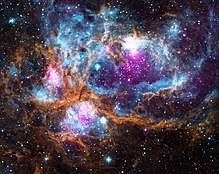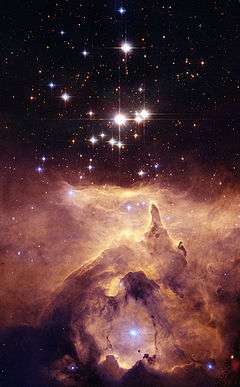NGC 6357
| Emission nebula | |
|---|---|
| H II region | |
 NGC 6357 composite image Credit: X-ray: NASA/CXC/PSU/L.Townsley et al.; Optical: UKIRT; Infrared: NASA/JPL-Caltech | |
| Observation data: J2000 epoch | |
| Right ascension | 17h 24m[1] |
| Declination | −34° 20′[1] |
| Distance | ~ 8000[2] ly |
| Constellation | Scorpius[3] |
| Designations | War and Peace Nebula,[1] Lobster Nebula [4] Sharpless 11, RCW 131, Gum 66 |
NGC 6357 is a diffuse nebula near NGC 6334 in the constellation Scorpius. The nebula contains many proto-stars shielded by dark disks of gas, and young stars wrapped in expanding "cocoons" or expanding gases surrounding these small stars. It is also known as the Lobster Nebula.[4][5]
This nebula was also given the name War and Peace Nebula by the Midcourse Space Experiment scientists because of its appearance. They said that in infrared images the bright, western part resembles a dove, while the eastern part looks like a skull.[6]
It is located about 5500 light years away from Earth.[7]
Associated Open Clusters
Pismis 24

This nebula includes the open cluster Pismis 24, which is home to several massive stars. One of the brightest stars in the cluster, Pismis 24-1, was thought possibly to be the most massive on record, approaching 300 solar masses, until it was discovered to be a multiple system of at least three stars; component stars would still remain near 100 solar masses each, making them among the more massive stars on record.[8][9]
G353.2+0.7
The young stellar cluster G353.2+0.7 lies east of Pismis 24 and was revealed by a Chandra X-ray image showing approximately 800 stars.[10]
G353.1+0.6
The young stellar cluster G353.1+0.6 lies southeast of Pismis 24 and also contains approximately 800 stars detected by X-ray.[10] The region includes several O-type stars, including [BDSB2003] 10.[11]
Massive stars
NGC 6357 is one of the most prominent sites of massive-star formation our neighborhood of the Milky Way. A variety of early O-type stars reside in this nebula, blowing the bubbles around the stars clusters that can be seen in the molecular cloud.
| Star (Pismis 24-#) |
Spectral type | Magnitude (Mbol) |
Temperature[13] (K) |
Radius (R☉) |
Mass (M☉) |
|---|---|---|---|---|---|
| 1NE | O3.5 If* | −10.0 | 42,000 | 17 | 74 |
| 1SW | O4 III | −9.8 | 41,500 | 16 | 66 |
| 2 | O5.5 V(f) | −8.9 | 40,000 | 12 | 43 |
| 3 | O8 V | −7.7 | 33,400 | 9 | 25 |
| 10 | O9 V | −7.2 | 31,500 | 8 | 20 |
| 12 | B1 V | −5.3 | 30,000 | 4 | 11 |
| 13 | O6.5 III((f)) | −8.6 | 35,600 | 12 | 35 |
| 15 | O8 V | −7.8 | 33,400 | 10 | 25 |
| 16 | O7.5 V | −9.0 | 34,000 | 16 | 38 |
| 17 | O3.5 III | −10.1 | 42,700 | 17 | 78 |
| 18 | B0.5 V | −6.4 | 30,000 | 6 | 15 |
| 19 | B0.5 V | −5.4 | 30,000 | 4 | 11 |
References
- 1 2 3 "NGC 6357". SIMBAD. Centre de données astronomiques de Strasbourg. Retrieved 2007-05-03.
- ↑ Nemiroff, R.; Bonnell, J., eds. (21 November 2010). "A Massive Star in NGC 6357". Astronomy Picture of the Day. NASA.
- ↑ R. W. Sinnott, ed. (1988). The Complete New General Catalogue and Index Catalogue of Nebulae and Star Clusters by J. L. E. Dreyer. Sky Publishing Corporation and Cambridge University Press. ISBN 0-933346-51-4.
- 1 2 Sample, Ian (20 February 2013). "Lobster Nebula – birthplace of stars – revealed in infrared". the Guardian.
- ↑ "Lobster Nebula Seen with ESO's VISTA Telescope Space Wallpaper".
- ↑ "2MASS Picture of the Week Archive Captions".
- ↑ "Winter Wonderland' Glows in Space as Nebula Is Wreathed in Wintry Colors". Space.com.
- ↑ "ESA Science & Technology: Star on a Hubble diet NGC 6357". Archived from the original on 2007-04-04. Retrieved 2007-04-11.
- ↑ Nemiroff, R.; Bonnell, J., eds. (19 December 2006). "NASA: Massive Stars in Open Cluster Pismis 24". Astronomy Picture of the Day. NASA.
- 1 2 Townsley, L. K.; et al. (2014). "The Massive Star-Forming Regions Omnibus X-Ray Catalog". Astrophysical Journal Supplement. 213 (1): 1. arXiv:1403.2576. Bibcode:2014ApJS..213....1T. doi:10.1088/0067-0049/213/1/1.
- ↑ Damke, G.; et al. (2006). "The open cluster G353.1+0.7 in NGC6357". Revista Mexicana de Astronomía y Astrofísica. 26: 180. Bibcode:2006RMxAC..26..180D.
- ↑ Fang, M.; Van Boekel, R.; King, R. R.; Henning, T.; Bouwman, J.; Doi, Y.; Okamoto, Y. K.; Roccatagliata, V.; Sicilia-Aguilar, A. (2012). "Star formation and disk properties in Pismis 24". Astronomy & Astrophysics. 539: A119. arXiv:1201.0833. Bibcode:2012A&A...539A.119F. doi:10.1051/0004-6361/201015914.
- ↑ Martins, F.; Schaerer, D.; Hillier, D. J. (2005). "A new calibration of stellar parameters of Galactic O stars". Astronomy and Astrophysics. 436 (3): 1049. arXiv:astro-ph/0503346. Bibcode:2005A&A...436.1049M. doi:10.1051/0004-6361:20042386.
External links
| Wikimedia Commons has media related to NGC 6357. |
- A Massive Star in NGC 6357 with a close-up of Pismis 24.
- Star Forming Region NGC 6357 showing complex interactions between interstellar winds, radiation pressures and magnetic fields.
- NGC 6357: Massive Stars
- A Massive Star in NGC 6357